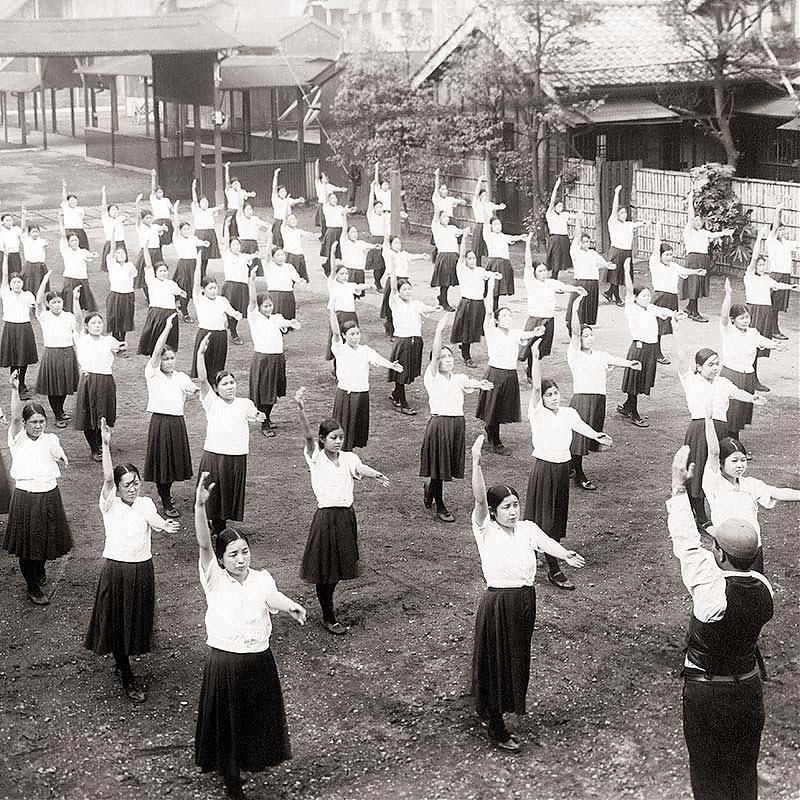Several geisha are relaxing at the Noryo Yuka (納涼床, summer platform) of a restaurant in Kyoto.
This photo appears to have been taken at Shijo Ohashi, on the western side of the Kamogawa. The woman in the light kimono is pouring sake, while one of the two women on the right is handing the other a kiseru pipe. Two Andon lamps have been placed on the matted floor.
Noryo Yuka first appeared during the Edo Period (1603-1867). Wealthy merchants in those days would entertain guests by placing folding stools called Shogi (床机) on the sandbanks and shallows of the Kamogawa. It offered them a welcome escape from Kyoto’s debilitating summer heat and high humidity.
During the Kambun era (1661-1673), flood-control works were carried out on the Kamogawa and both banks of the river were fortified with masonry. As a result of this, tea houses and food stalls (yatai) selling everything from cut watermelon to tofu-dengaku (tofu dish baked and coated with miso) started to appear. There were also acrobats, jugglers and other street performers, creating a never-ending festival atmosphere which attracted bustling crowds. Around this time, Noryo Yuka started to take their form as actual platforms.
During the early Meiji Period (1868-1912), many new rules and regulations were adopted and Noryo Yuka did not escape. The period for Noryo Yuka was set for July through August, a mere two months.
The modernization of Japan, begun in the Meiji Period, also affected the appearance of Noryo Yuka. Many semi-permanent platforms made with steel legs, some even with roofs, were made during the Taisho Period (1912-1926).
They didn’t last long. In June 1935 (Showa 10), all Noryo Yuka were washed away during a severe downpour. Maintenance work carried out after this disaster resulted in the Noryo Yuka as they appear today.
During WWII, Noryo Yuka were prohibited, but they were started up again by a small number of restaurants in 1951 (Showa 26). Over the next few years they became once again increasingly popular and some 40-50 restaurants applied for permission to build Noryo Yuka.1
These days some 90 Noryo Yuka are built every summer between Nijo-dori and Gojo-dori. They can be used from May 1 to September 30 when they offer a cool respite from the muggy summer heat. In May and September they are open during the day, but from June through August they can only be enjoyed during the evening.
The acrobats and dancing prostitutes may have long disappeared, but a summer evening along the Kamogawa is once again a memorable experience.
This photograph has over the years been attributed to a large number of photographers. A recently rediscovered article in the September 1896 issue of The Practical Photographer credits it to the amateur photographer Yuji Isawa (伊澤雄司), editor of the Shashin Sowa (冩真叢話), finally solving the attribution question.2
Notes
Find more detailed info about Noryo Yuka at 京都鴨川納涼床協同組合 (Japanese).
1 京の風物詩 京都鴨川納涼床への誘い。納涼床の歴史。 Retrieved on 2008-06-04.
2 Bennett, Terry (2006). Old Japanese Photographs: Collectors’ Data Guide. Bernard Quaritch Ltd., 39. ISBN 0955085241
Also: 国立国会図書館 冩真叢話(1891, No. 2).
Published
Updated
Reader Supported
Old Photos of Japan aims to be your personal museum for Japan's visual heritage and to bring the experiences of everyday life in old Japan to you.
To enhance our understanding of Japanese culture and society I track down, acquire, archive, and research images of everyday life, and give them context.
I share what I have found for free on this site, without ads or selling your data.
Your support helps me to continue doing so, and ensures that this exceptional visual heritage will not be lost and forgotten.
Thank you,
Kjeld Duits
Reference for Citations
Duits, Kjeld (). Kyoto 1890s: Geisha on Summer Platform, OLD PHOTOS of JAPAN. Retrieved on December 14, 2025 (GMT) from https://www.oldphotosjapan.com/photos/263/geisha-summer-platform-kyoto-noryo-yuka-1890s




Giancarlo Sulas
It is so beautiful. I love Japan
#000308 ·
Courtney Halcomb
I have this print!! My print says “Girls For Cooling At Kamogawa,Kioto.
#000599 ·
Kjeld Duits (Author)
@Courtney Halcomb: Yes, you can see the Kamogawa River in the background. You are lucky to have this print; it is beautiful!
#000602 ·
Noel
I still have doubts about the photographer attribution. The same photo is included in Kazumasa Ogawa’s “Illustrations of Japanese Life” (1896) and in the preface he states: “I have to acknowledge my indebtedness to Messrs. Tamamura and S. Kajima, as well as Prof Burton, for several of the plates in this volume.” Earlier, Courtney Halcomb wrote she has a copy labeled “Girls For Cooling At Kamogawa,Kioto”, that is actually Kajima Seibei’s no. 1521.
The other attribution option is:
http://oldphoto.lb.nagasaki-u.ac.jp/en/target.php?id=2610
I’ve been trying to identify the photographer, who used this particular label. From a group of more than 200 photos this one is the first that shares a label attribution to another photographer (Seibei).
As for my personal experience I would say the models and composition of the image has a strong Tamamura Kozaburo’s feel.
#000619 ·
Kjeld Duits (Author)
Thank you, Noel.
Photographers selling each others prints at the time has made contribution a huge headache.
It would be nice if we could find a definitive answer to the attribution of this image, as well as many others. So, I hope you can find more information.
Until then, the attribution to Y. Osawa is the best we have.
#000620 ·
Noel
There is another thing I noticed about this photo. You wrote that the two women on the right are playing Jan-ken-pon, but in fact they are passing each other what seems to be a kiseru pipe.
#000621 ·
Kjeld Duits (Author)
You are right, Noel! How did that slip in?
#000622 ·